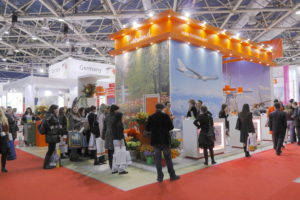Physical vs Virtual Events – a mini crash course
Angie Kellen, Director, Client Services, Open Sky Communications
 While COVID-19 has slammed the door on in-person (physical) tradeshows and technical conferences for 2020, virtual events have sprung up as an alternative. The question is: will this alternative platform replace the physical events permanently? To answer that question, we need to answer another question: are virtual events as effective as physical events? By now, most of us in the communications fields have attended many tradeshows and conferences in person. However, I suspect that there are a significant number of us that have not attended a virtual event before COVID-19. That means that there is a steep learning curve for everyone in the virtual event ecosphere from event organizers and speakers to attendees and booth sponsors. We are all looking for ways to maximize the virtual platform to meet our company’s goals around branding, marketing and sales. Recently, I attended a virtual event and have been reading up on what others have shared about the positives and the negatives of virtual vs physical events. A key semiconductor industry event, SEMICON West, will be held virtually next month. I am looking forward to exploring the ways in which the many technology tracks and exhibits will be represented. I hope you find this blog to be a helpful mini crash course as I share some of my research as well as my experiences with this topic.
While COVID-19 has slammed the door on in-person (physical) tradeshows and technical conferences for 2020, virtual events have sprung up as an alternative. The question is: will this alternative platform replace the physical events permanently? To answer that question, we need to answer another question: are virtual events as effective as physical events? By now, most of us in the communications fields have attended many tradeshows and conferences in person. However, I suspect that there are a significant number of us that have not attended a virtual event before COVID-19. That means that there is a steep learning curve for everyone in the virtual event ecosphere from event organizers and speakers to attendees and booth sponsors. We are all looking for ways to maximize the virtual platform to meet our company’s goals around branding, marketing and sales. Recently, I attended a virtual event and have been reading up on what others have shared about the positives and the negatives of virtual vs physical events. A key semiconductor industry event, SEMICON West, will be held virtually next month. I am looking forward to exploring the ways in which the many technology tracks and exhibits will be represented. I hope you find this blog to be a helpful mini crash course as I share some of my research as well as my experiences with this topic.
Let’s start with the key elements of an event and see how the physical and virtual events stack up against one another. I found this information in a blog from 6Connex and while they are a provider of software and services for online events, I agree with this comparison based on my experiences.
Physical vs Virtual Events
FLEXIBILITY
Physical events usually only last 2-3 days before closing their doors.
Virtual events can stay live for 30-90 days, or even all year round.
COST EFFECTIVE
Physical events require renting event spaces, hiring staff, and costs associated with travel, food, hotels and entertainment.
Virtual events are much more cost effective. Big speakers charge less and your entire global team can attend.
NETWORKING
Handshakes, eye-contact, and happy hours make physical events a “cocktail” for networking success.
Virtual events make perusing booths and interacting with sales reps easier and more relaxing.
MASS DATA
Many physical events only collect a sign-in sheet worth of data.
Virtual events can provide extremely useful data insights that help you nurture hot leads.
CUSTOMIZED MERCHANDISE
Customized merchandise is a great way for companies to leave their mark in the mind (and on the backs) of attendees.
Although some virtual events create personalized merchandise for staff and/or speakers, it is not nearly as common.
LONG-TERM ROI EFFECTS
Physical events leave behind strong brand association and fond memories that build authority over time.
Virtual events improve both short- and long-term bottom lines, dramatically increasing brand visibility and authority.
Virtual Conferences vs Virtual Trade Shows
It seems that conferences have had an easier time moving to a virtual format over the tradeshows that include both speakers and exhibits. I think conferences have moved to the virtual space more easily because we, the attendees, are already used to getting our content online through webinars, YouTube videos, etc. But tradeshows have exhibits and this adds a different set of challenges when moving to the virtual environment. The key challenge and question for event organizers is how can you recreate the value of a tradeshow online for exhibitors when historically they’ve been designed to be an in-person experience?  For attendees, why would you attend and pay for a virtual tradeshow vs simply researching and requesting a demo from an exhibitor’s website? Virtual event platforms are struggling to answer these questions with innovative applications. While the demand is off the charts for robust platforms, they are still a work in progress to successfully transition the tradeshow experience to a virtual environment. Let’s take a look at a few things that the virtual tradeshow platform will need to reproduce from physical events.
For attendees, why would you attend and pay for a virtual tradeshow vs simply researching and requesting a demo from an exhibitor’s website? Virtual event platforms are struggling to answer these questions with innovative applications. While the demand is off the charts for robust platforms, they are still a work in progress to successfully transition the tradeshow experience to a virtual environment. Let’s take a look at a few things that the virtual tradeshow platform will need to reproduce from physical events.
Conversational exchange of ideas – new discoveries
So much can be learned by dropping by a booth, talking about industry trends, learning about new products from on-site demos and making connections with old and new acquaintances. Let’s not forget about the accidental discoveries, such as a new customer or supplier, that are made when wandering the tradeshow floor.
Product launches, demos – lead generation
Exhibitors must be able to provide product demos on demand, since these requests offer unique branding opportunities in front of a targeted audience. While demos can easily be provided in a virtual environment, what is missing is the interpersonal and sensory experience from the demo provider.
New Business – Sales
Many of us still want to touch or ‘kick the tires’ on a product before we buy it. Exhibitors now face new challenges in this new format as they work to attract customers, and particularly decision makers, to view demos and consider deals in the virtual environment.
As you can see, there are several challenges to transitioning the tradeshow experience to a virtual space. If you are considering organizing a virtual event or becoming a virtual exhibitor, you will want to consider and understand the capabilities that are available today. You will want to ensure the virtual platform you are using includes live video chat, live chat rooms or the ability to host a live demo session as these are crucial to recreate typical tradeshow interactions. It is extremely important to have ways to foster connections made at virtual events. Another solution involves investing in more content-oriented materials such as high-production-value presentations and educational items at virtual booths. These can take the form of professional videos, webinars and marketing materials that can be downloaded. I have listed only a few of the things you will want to consider, but there are many more.
 Recently, I signed up as an attendee for a two-day virtual event in the connected lighting industry purely to see how it all worked. This event had speaker tracks as well as exhibits and I found it to be very well organized. The biggest help was the ‘Welcome’ page that included detailed information on all the various aspects of the virtual tradeshow. The graphics were set up to mimic walking into a typical tradeshow environment. You started in the Lobby, which had links to the Exhibit Hall, Auditorium, Lounge and Resource Center. The navigation buttons at the top of the screen also included links to a Video Vault, Leaderboard and Swag Bag sections. This is what I observed:
Recently, I signed up as an attendee for a two-day virtual event in the connected lighting industry purely to see how it all worked. This event had speaker tracks as well as exhibits and I found it to be very well organized. The biggest help was the ‘Welcome’ page that included detailed information on all the various aspects of the virtual tradeshow. The graphics were set up to mimic walking into a typical tradeshow environment. You started in the Lobby, which had links to the Exhibit Hall, Auditorium, Lounge and Resource Center. The navigation buttons at the top of the screen also included links to a Video Vault, Leaderboard and Swag Bag sections. This is what I observed:
Auditorium – this is where the speaker presentations were found. There was a running agenda so you knew what was coming up. Wisely, the keynotes for both days were held around 11 a.m. Pacific Time. This allowed others from around the globe to have time to listen in live or have access to the presentation two hours later according to their time zone. I liked that during and after each presentation there was a live chat stream set up to ask questions of the speaker in real time. Several panels were on the agenda and they resembled a webinar with the panelists as static photos and voice overs.
Exhibit Hall – there were 12 virtual booths and they all looked the same except for the various company logos. This can be a good thing as it puts everyone on the same level and no one is placed in the shadows of another company’s enormous booth. Upon clicking on each booth, the difference was the materials each company provided. Some had several videos on the company as well as a new product, while others had only brochures that were available for download. The differentiation between companies was in the visuals and downloads they provided the attendee. Several booths had a live chat stream and when you clicked on their booth, they greeted you. I found this to be a great way to make connections.
Lounge – to mirror the many connections made during cocktail events at tradeshows, the lounge provides a virtual place to go to reconnect with existing acquaintances or make new ones that may have sprung up when in the speaker chat rooms or booth chat rooms. I think the lounge is a good idea and one that was well used.
Swag Bag – while tradeshows provide giveaways to the attendees, a virtual environment provides some challenges.  However, those giveaways that were provided were mainly industry trend reports that could be downloaded with the company’s logo and letterhead.
However, those giveaways that were provided were mainly industry trend reports that could be downloaded with the company’s logo and letterhead.
Leaderboard – this is good and bad. First, there is a contest where you get points for clicking on videos, attending keynotes and other presentations, clicking on booths and finding the hidden icons planted throughout the entire virtual venue. The leaderboard is a live list of attendees with the most points. I was busy setting up my calendar for the various speakers that I wanted to hear live. Once that was done, I started to click on some of the found icons and visited the various booths. I happened to check the leaderboard and my name was seventh from the top! Suddenly my competitive side kicked in and I was soon clicking away to get more points and move up the leaderboard to win an iPad. Interestingly, while I was going through the motions to click and gain points, as opposed to clicking to learn more about a company, I still came away with a good understanding of the various companies and product offerings. Again, this can be good or bad, but definitely good for the organizers that need to show traffic to the exhibitors’ booths!
My experience with the virtual tradeshow was a positive one. Had I been an exhibitor, there were ample channels for me to make those connections and present my products in a meaningful way. But, there is more that can be done and by using our creativity they will become available.
Lucky for all of us, the global stay-in-place mandates have inspired some very creative people to develop innovative ways to enhance the user experience for virtual events. Since most of us are in a steep, virtual event learning curve, the information below may provide you with a few fresh ideas on how to make your hosting of and presence at virtual events a success. Keep in mind, this is not a comprehensive list, but it should provide you with some good insights on virtual events.
Victoria Copans, who worked for an events agency before becoming a writer about the industry, points out some original ideas from recent online events to help inspire your own. I have reproduced portions of her list below from her blog:
Live Games or Competitions
As part of Salesforce’s World Tour Sydney Reimagined virtual event, they implemented a live “battle of the apps” competition between exhibitors — complete with audience voting — called AppExchange Demo Jam.
During this session, Salesforce AppExchange partners were given three minutes each to do a live demo of their apps. The audience was then asked to vote for their favorite app using a dedicated link that was accessible for 24 hours following the session, and the winner was announced on Twitter the next day.
Featuring sponsors and exhibitors through this kind of competition is a creative way to provide engaging demos while also getting the audience involved. Keeping the demos short and to-the-point is also beneficial considering that many attendees of virtual events will face more distractions while viewing at home. Plus, this kind of activity will have people checking back to and engaging with the event’s social media pages to see who won.
High-Production Value Content on Demand
Live streaming is often the backbone of virtual events, and it can be a very effective way to replace in-person presentations and sessions. However, there are other approaches that may work for your event, depending on your goals and the scale of the event. For example, Adobe decided to forego live streams for their recent Summit and went the prerecorded route instead.
What prerecorded sessions may lack in real-time engagement, they make up for in production value, as they benefit from the ability to be edited or enhanced. This can greatly improve certain speakers’ performances. They also eliminate many common challenges of virtual events, such as planning around different time zones and connectivity issues during the event. With people viewing the content on their own time, you’ll want to erect forums or schedule specific times for Q&As and networking sessions where people can connect about the topic and continue the dialogue.
Immersive Environments
While many virtual events are implementing virtual expo booths and networking tools, some are working to re-create the trade show experience by making the visuals seem as if you are actually attending a physical event.
For example, the home screen from which attendees can access the different parts of the event is named Lobby and features a background of a convention center lobby. Similarly, the Networking Lounge feature looks like an actual lounge with chat windows that attendees can interact with.
Although not quite VR, these environments will allow attendees to feel familiar aspects of event spaces through the virtual format instead of just clicking through screens and videos that all look the same. Using design elements to give your event a unique look and feel will help set your event apart and serve to distinguish various spaces within the event as well.
Virtual Entertainment
Just because you’ve brought your event online doesn’t mean that you need to forego entertainment. Certain entertainment opportunities, such as musical performances, can translate very well to virtual events. For smaller affairs, including a live-streamed performance can add a special touch to your event.
People are missing concerts, shows, and countless other in-person experiences due to the pandemic, so incorporating a performance of some sort is a nice way to bring entertainment directly to them.
Health and Wellbeing Activities
Online workout and dance videos are the only options for many people looking to exercise during this pandemic, and incorporating these types of activities into your event is a good way to switch things up and deliver unexpected value to attendees.
Depending on the format of your event, you could organize a short workout or meditation break in between sessions, or have a separate stream for these kinds of activities that attendees can tune into throughout the event for a change of pace.
Intro Tutorial Video
It’s important to remember that many attendees may not be used to navigating and attending virtual events, and may need a little help. For example, a video can act as a brief tutorial that introduces attendees to the platform’s different features and instructs them on how to interact with the various pages.
Making sure everyone is comfortable with the platform and familiar with how the event will work is an important step in ensuring attendees take advantage of everything you’ve implemented.
Incentives to Engage Online
Giveaways are always a good way to increase engagement with attendees and can be a fun addition to a virtual event. Although it’s not quite as simple as handing an attendee their prize, there are virtual goodies you can offer, and there’s still the option of mailing physical incentives to attendees following the event.
I hope that this mini crash course has provided you with enough information to make some sound decisions on virtual events whether an organizer of exhibitor. Will the virtual realm take over the physical events? I don’t think so, but I feel that we will see the emergence of hybrid events that take the best of both physical and virtual platforms and provide the event goers with an exceptional experience. As the virtual platforms continue to evolve, I very much look forward to what is next for virtual events.
